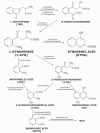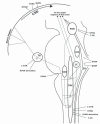Kynurenine metabolites and migraine: experimental studies and therapeutic perspectives
- PMID: 22131946
- PMCID: PMC3131728
- DOI: 10.2174/157015911795596621
Kynurenine metabolites and migraine: experimental studies and therapeutic perspectives
Abstract
Migraine is one of the commonest neurological disorders. Despite intensive research, its exact pathomechanism is still not fully understood and effective therapy is not always available. One of the key molecules involved in migraine is glutamate, whose receptors are found on the first-, second- and third-order trigeminal neurones and are also present in the migraine generators, including the dorsal raphe nucleus, nucleus raphe magnus, locus coeruleus and periaqueductal grey matter. Glutamate receptors are important in cortical spreading depression, which may be the electrophysiological correlate of migraine aura. The kynurenine metabolites, endogenous tryptophan metabolites, include kynurenic acid (KYNA), which exerts a blocking effect on ionotropic glutamate and α7-nicotinic acetylcholine receptors. Thus, KYNA and its derivatives may act as modulators at various levels of the pathomechanism of migraine. They can give rise to antinociceptive effects at the periphery, in the trigeminal nucleus caudalis, and may also act on migraine generators and cortical spreading depression. The experimental data suggest that KYNA or its derivatives might offer a novel approach to migraine therapy.
Keywords: Cortical spreading depression; glutamate; kynurenic acid; kynurenine metabolites; migraine; migraine generators; trigeminal system..
Figures



Similar articles
-
Altered kynurenine pathway metabolites in serum of chronic migraine patients.J Headache Pain. 2015;17:47. doi: 10.1186/s10194-016-0638-5. Epub 2016 Apr 29. J Headache Pain. 2015. PMID: 27130315 Free PMC article.
-
The L-kynurenine signalling pathway in trigeminal pain processing: a potential therapeutic target in migraine?Cephalalgia. 2011 Jul;31(9):1029-38. doi: 10.1177/0333102411404717. Epub 2011 May 18. Cephalalgia. 2011. PMID: 21593189 Review.
-
[New perspectives in the treatment of migraine: the role of the kynurenine pathway in the pathophysiology of migraine].Orv Hetil. 2025 Jun 8;166(23):879-886. doi: 10.1556/650.2025.33327. Print 2025 Jun 8. Orv Hetil. 2025. PMID: 40483687 Review. Hungarian.
-
Kynurenines and headache.J Neural Transm (Vienna). 2012 Feb;119(2):285-96. doi: 10.1007/s00702-011-0665-y. Epub 2011 Jun 4. J Neural Transm (Vienna). 2012. PMID: 21643792 Review.
-
Tryptophan Catabolites and Migraine.Curr Pharm Des. 2016;22(8):1013-21. doi: 10.2174/1381612822666151214105439. Curr Pharm Des. 2016. PMID: 26654771 Review.
Cited by
-
Kynurenines in the CNS: recent advances and new questions.Nat Rev Drug Discov. 2013 Jan;12(1):64-82. doi: 10.1038/nrd3793. Epub 2012 Dec 14. Nat Rev Drug Discov. 2013. PMID: 23237916 Review.
-
Neurogenic Inflammation: The Participant in Migraine and Recent Advancements in Translational Research.Biomedicines. 2021 Dec 30;10(1):76. doi: 10.3390/biomedicines10010076. Biomedicines. 2021. PMID: 35052756 Free PMC article. Review.
-
The Organ of Vision and the Stomatognathic System-Review of Association Studies and Evidence-Based Discussion.Brain Sci. 2021 Dec 23;12(1):14. doi: 10.3390/brainsci12010014. Brain Sci. 2021. PMID: 35053758 Free PMC article. Review.
-
Citalopram Neuroendocrine Challenge Shows Altered Tryptophan and Kynurenine Metabolism in Migraine.Cells. 2022 Jul 21;11(14):2258. doi: 10.3390/cells11142258. Cells. 2022. PMID: 35883701 Free PMC article. Clinical Trial.
-
Ion Channel Disturbances in Migraine Headache: Exploring the Potential Role of the Kynurenine System in the Context of the Trigeminovascular System.Int J Mol Sci. 2023 Nov 21;24(23):16574. doi: 10.3390/ijms242316574. Int J Mol Sci. 2023. PMID: 38068897 Free PMC article. Review.
References
-
- The International Classification of Headache Disorders: 2nd ed. Cephalalgia. 2004;24(Suppl 1):9–160. - PubMed
-
- Lipton RB, Stewart WF, Diamond S, Diamond ML, Reed M. Prevalence and burden of migraine in the United States: data from the American Migraine Study II. Headache. 2001;41(7):646–657. - PubMed
-
- Moskowitz MA. Defining a pathway to discovery from bench to bedside: the trigeminovascular system and sensitization. Headache. 2008;48(5):688–690. - PubMed
-
- Weiller C, May A, Limmroth V, Juptner M, Kaube H, Schayck RV, Coenen HH, Diener HC. Brain stem activation in spontaneous human migraine attacks. Nat. Med. 1995;1(7):658–660. - PubMed
LinkOut - more resources
Full Text Sources
Miscellaneous
